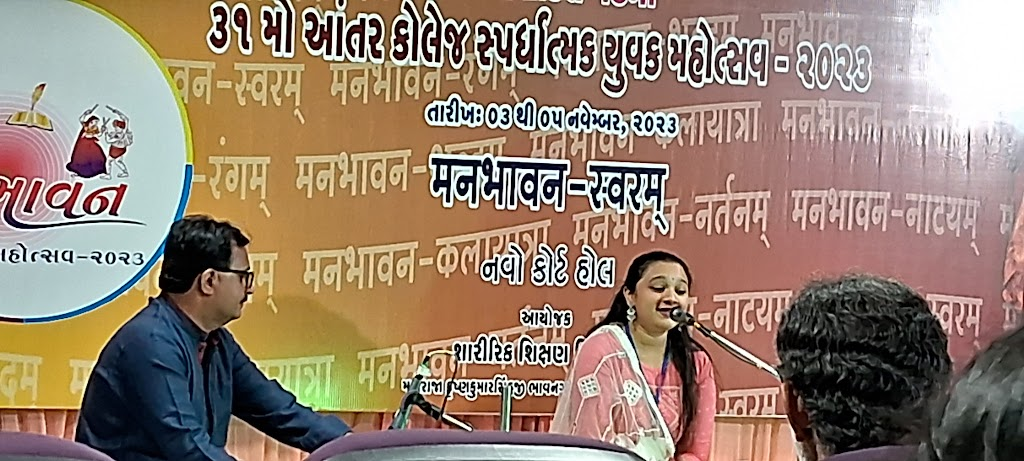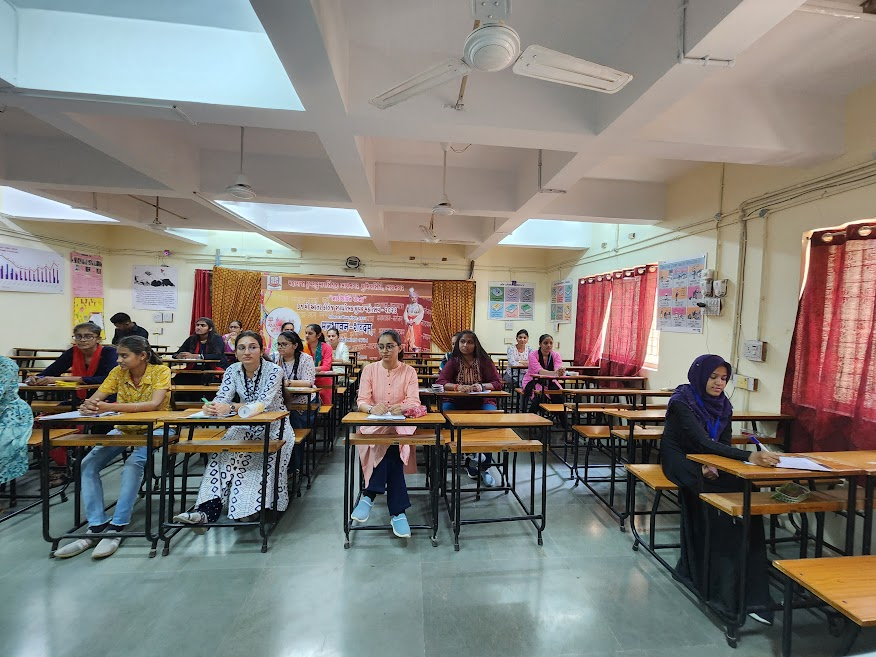Welcome to my blog,
This blog is part of our study. This blog is based on Youth Festival 2023 and was assigned by Dr. Dilip Barad sir Department of English MKBU. In this task, I am going to share my experience and write on it and also share some photos and videos of Youth Festival 2023.
मन भावन Man Bhavan મન ભાવન
The Youth Festival 2023, is an extravaganza hosted by the esteemed Maharaja Krishnakumarsinhji Bhavnagar University from November 3rd to 5th. Embark on a journey with me as I share my personal encounters and unravel the diverse array of activities and experiences this dynamic celebration had to offer.
Under the enthusiastic guidance of the Physical Education Department, this 31st edition of the festival, aptly named "Manbhavan Yuvak Mahotsav," added an invigorating twist to the festivities. The campus came alive with the spirit of youth, echoing with cheers, laughter, and the pulsating beats of creativity. The vivid colors and imaginative creations served as a testament to the boundless creativity of the young minds at Bhavnagar University. It was more than just an exhibition; it was a celebration of artistic expression.
Being part of the planning and participating in these festivities proved to be a super fun way to grow personally.
Our steps as we followed a well-crafted schedule, ensuring that every moment unfolded seamlessly from November 3rd to 5th.
The festival, themed "Nari Shakti Vandana," showcased 32 different competitions across five dynamic sections. Each section, representing Literature, Music, Fine Arts, Dance, and Theatre, bore a distinctive name, infusing the event with a unique flavor:
- "मनभावन रंगमच" - External Department
- "मनभावन नाट्यम" - Atal Auditorium
- "मनभावन शब्दम" - English Department
- "मनभवन स्वरम" - New Court Hall
- "मनभावन नृत्यम" - Amphi Theatre
Kala Yatra
November 2nd marked the festival's inaugural day, "Kala Yatra," where diverse themes came to life. The English Department, with "Oppression to Freedom," crafted a compelling narrative. Alongside, themes like Chandrayaan-3 celebrated space exploration, and Narishakti Vandana paid homage to powerful women.
Each theme told a unique story. Chandrayaan-3 highlighted India's space journey, honoring women's pivotal role. Narishakti Vandana showcased the strength of women through goddess worship. Another theme explored historical contributions, while ours traced women's evolution from tradition to modern success.
Our display portrayed women's struggles, from issues like child marriage to workplace challenges. Yet, it wasn't just about hardships. We celebrated women breaking barriers in business, law, sports, and more. "Kala Yatra," was more than a display—it was a collective effort to tell stories, evoke emotions, and illuminate the journey from oppression to freedom. Cheers to collaboration, dedication, and mentorship that made our narrative resonate.
Opening / Inauguration of "Youth Festival"
On November 3rd, the "Youth Festival" opened its doors to a spectacular inauguration, graced by distinguished guests: M.M. Trivedi, Sagardan Gadhvi, Hetal Mehta, Ami Upadhyay, and Bhartiben Shiyal. Two dynamic students hosted the event, infusing it with a contagious energy.
Sagardan Gadhvi, with his enchanting voice, cast a musical spell, leaving the audience captivated. The Kalapath Group added to the enchantment with a Narivandana-themed Stuti, delivering soul-stirring renditions of "Jay Jay Jag Janni Devi" and "Aygiri Nandini." The esteemed guests not only graced the occasion but also shared insights into the National Education Policy 2020, underscoring its pivotal role in holistic student growth. Their talks not only added depth to the event but also made it thoroughly enjoyable. The "Youth Festival" opening transcended mere ceremony; it was a harmonious blend of talents, melodies, and enlightening discussions. As the curtains lifted on this grand celebration, the promise of vibrant festivities and valuable insights set the tone for an unforgettable experience ahead.
"मनभावन नृत्यम" - Amphi Theatre
The folk dances at the Youth Festival were nothing short of incredible! Each performance was a vibrant showcase of our diverse culture, featuring dances like Adivasi Ras, Mishra Ras, Prachin Garbo, Arvachin Garbo, Tippni, Hudo, Timli, and many more. Executing these dances demanded an immense amount of energy, and the dancers looked absolutely stunning in their traditional attire. The lively music, accompanied by enthusiastic group singing, added to the overall excitement. Undoubtedly, folk dance emerged as the highlight, making the youth festival an exhilarating experience for everyone.
Classical dance, another jewel in our cultural crown, unfolded with grace and beauty. Dancers adorned in specific attire conveyed intricate emotions through their facial expressions. Watching these performances was akin to witnessing our culture come alive—it was truly mesmerizing! The intricate movements and expressions painted a vivid picture of our heritage, leaving the audience enchanted and appreciative. In the realm of the Youth Festival, folk and classical dances stood out as not just performances but as powerful reflections of our rich cultural tapestry.
"मनभावन नाट्यम" - Atal Auditorium
The Youth Festival took the stage with a diverse array of dramatic performances, each weaving unique narratives. In compelling one-act plays such as "Kashmir Crisis," "Laxmi," and "વાત એક વ્યથાની," the exploration delved into harsh realities, societal issues, and reimagined ancient tales. These performances courageously tackled themes of loss, violence, societal expectations, and the evolving roles of women in our society.
Skit performances, both entertaining and thought-provoking, addressed issues ranging from superstitions and road construction challenges to cultural clashes and cybercrimes. The aim was not only to entertain but also to shed light on pressing societal problems that demand attention.
Mono acting, with its solo spotlight, covered a spectrum of topics including gender challenges, poverty, college issues, and poignant personal stories. Each monologue provided a unique lens into the complexities of human experience.
Mime performances, a silent yet powerful art form, conveyed stories on diverse themes like women empowerment, outdoor games, India's achievements, and the life of a soldier—all expressed without a single word. These silent narratives spoke volumes, capturing the essence of varied subjects.
For those interested in exploring these performances from a dramatic literary perspective, applying theories such as Aristotle's Tragedy, Jonson's Comedy of Humours, and Dryden's Play could offer fascinating insights into the nuanced storytelling at the festival. The Youth Festival, through its dramatic presentations, not only entertained but also served as a mirror reflecting the myriad facets of our society and culture.
"मनभवन स्वरम" - New Court Hall
"मनभावन रंगमच" - External Department
1) Cartooning:
Cartooning, a departure from traditional painting, is a dynamic storytelling medium with the power of humor, critique, and social commentary. Cartoonists leverage exaggeration for satire, making their perspectives vivid. Beyond entertainment, cartoons serve as a form of critique, addressing injustices, inequalities, or absurdities. Whether in editorial cartoons, comic strips, or webcomics, cartoons contribute to ongoing dialogues about society, provoking thought and entertaining. Dhatri from Semester-1 secured the second rank, illustrating themes like "મોંઘવારી," "ચૂંટણી," and "ગાંધીજી અને જનતા."
2) Poster Making:
Participants crafted posters on "Vrudhdhoni Seva" (Service to the Elderly), "Pani Bhachavo" (Save Water), and "Kanya Shikshan" (Education for Girls).
3) On the Spot Painting:
Hina from Semester 3 showcased her artistic flair in on-the-spot painting with the theme Celebration of Festivity, Salutations to Women Power.
4) Clay Modelling:
Clay modeling explored themes like "માતૃપ્રેમ," "ગ્રામ્ય જીવન," and "સંગીતકાર."
5) Installation:
The English Department's team, comprised of Pooja Bhuva, RajeswariBa Rana, and Bhvayata Kukadiya, participated in the installation competition, showcasing creativity in a vibrant display.
"मनभावन शब्दम" - English Department
The Poetry Competition at the English Department was more than an event; it was a journey into a realm of creativity. The air was filled with the enchanting verses of new poets, each sharing their unique works, creating a tapestry of literary artistry.
What added an extra layer of coolness to the competition were the three superlative judges: Parul Khakhar, Snehi Parmar, and Ketan Kanpariya. These literary superheroes brought their own brand of magic to the event, infusing it with their profound understanding of words and their knack for crafting awe-inspiring literature.
Their presence elevated the competition, making it a truly special experience. Parul Khakhar, Snehi Parmar, and Ketan Kanpariya, all outstanding writers, brought a wealth of knowledge and a deep love for literature to the judging table.
Essay Competition: A Literary Exploration
In the realm of the Essay Competition, participants embraced the challenge, and among our department's contributors, Insiya stood out. The canvas of topics was diverse, offering a broad spectrum for exploration:
1. India's Space Odyssey:
Embarking on a captivating journey into India's space achievements, challenges, and future aspirations—a narrative that unraveled the nation's cosmic endeavors.
2. From the Kitchen to Cabinet - Women, Don't Give Up:
A compelling reflection on the metamorphosis of women's roles, underscoring resilience and determination in breaking barriers from domestic spheres to positions of leadership.
3. Are Wars Inevitable?:
A thought-provoking examination of the factors fuelling conflicts, pondering the potentiality of steering away from wars and seeking alternative paths towards peaceful resolutions.
4. The Importance of Value-Based Education:
An insightful exploration of the pivotal role values play in education, scrutinizing their impact on personal development and societal well-being.
5. Plastic Pollution - Problems & Resolution:
A comprehensive analysis of the challenges posed by plastic pollution, coupled with potential resolutions and a call to collective responsibility in addressing this pressing environmental issue.
Quiz Competition
In the thrilling Quiz Competition, quick thinking and knowledge collided! Here's a rapid recap of the highlights, where participants showcased their intellect, strategic thinking, and passion for learning.
The amphitheater witnessed the grand finale—the Closing Ceremony, a spectacular show that brought the Youth Festival to a thrilling close! A lineup of impressive guests graced the event, including Sejalben Pandya from the West Zone Parliament, Niren Bhatt, Dilipsinhji Gohil, and other esteemed EC members.
Anticipation hung in the air as the top three performers in each event were announced. The winners erupted in joy, seizing their well-deserved medals and certificates. Adding to the excitement, KPES College secured the runners-up title, heightening the competitive spirit.
The pinnacle of triumph belonged to the Swami Sahjanand Cluster of Colleges, clinching the coveted General Championship trophy. As the cheers echoed and the celebrations reverberated, the Closing Ceremony was a fitting conclusion to an eventful Youth Festival. Stay tuned for more highlights and unforgettable moments! Refresh for the grand finale experience.
The Maharaja Krishnakumarsinhji Bhavnagar University has once again proven that youth is not just a demographic but a force that can shape the future with its boundless energy and vibrant spirit. Cheers to the youth, cheers to the festival, and cheers to the memories that will forever be etched in the annals of Bhavnagar University's history.
Word Count - 1945























